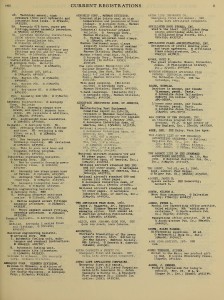There are about 70 million cards and record book pages among the pre-1978 Copyright records. I thought it might be interesting to show some examples of these paper records, kind of a show and tell post. Three types of records are shown below. Click on any of the thumbnails below to see a larger image.
The following are examples of cards in the Copyright Card Catalog. These are the principal finding aids for titles, authors, claimants and other names associated with the ownership of copyrights. Our vision is to create a data record from the content of these cards and make that available online for searching. Linked to each data record would be images of the cards as well as the respective pages from the record books (see below) showing the full information about each registration and each assignment or transfer of rights.
Requests and applications for copyright registration are found in the record books. The books are organized by year, class and the assigned number. Once a registration number is found using the card catalog, the record books can be consulted for the full set of copyright facts about the work. These are a few examples.
An alternate finding aid is the published Catalog of Copyright Entries. These were periodic compilations of registration records in catalog card format distributed through the Federal Depository Library Program.
I hope you found this glimpse at some of the records interesting. As always your comments are most welcome. Last week’s post was about our short term strategies. If you haven’t seen it, you might want to take a look (Copyright Records: Short term strategies for making them more accessible).









January 8, 2012 at 9:00 pm
This is a terrific endeavor, which promises to help bring the Copyright Office into the 21st century. Making pre-78 records available online is critical to bringing transparency to the Office and to providing the public with easily accessible tools to assess copyright rights. I particularly like the blog as a means to communicating these efforts to the public and for obtaining feedback. Hopefully, the end result of the digitization effort will be as easy to use as TARR and TDR in the U.S. Trademark Office (TESS could be more user friendly). This particular post gives an interesting insight into the challenges of the project and creates an important historical archive for when people no longer have to think about the underlying paper records.
January 9, 2012 at 2:31 pm
Thanks for the visual examples. If ever possible, it would be nice to see examples of an item that has been renewed multiple times and see its copyright genealogy visually displayed.
January 9, 2012 at 2:39 pm
BRAVO! an effort well worth the time it will take to properly image, index and maintain these records based on their relative value…. and glad to see the thought process included digitize the finding aids, and provide pointers to the source materials to find the balance of the detail. So many times, the knee-jerk reaction is to “scan everything”, when that isn’t typically the best use of effort or funds.
Have you considered seeing if there may be NHPRC Grant funds available to assist in this project? I think it might be worthwhile.
December 2, 2012 at 2:26 pm
Dear Susie,
It is not possible for the Copyright Office to provide you with “examples of an item that has been renewed multiple times” because a copyright may be renewed only once. I hope that helps.